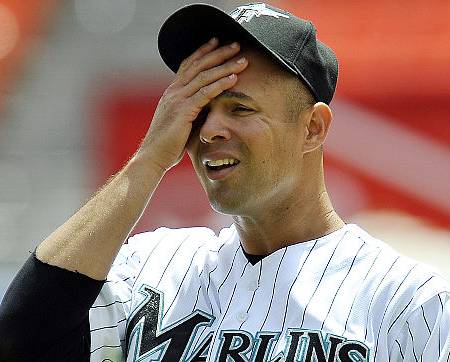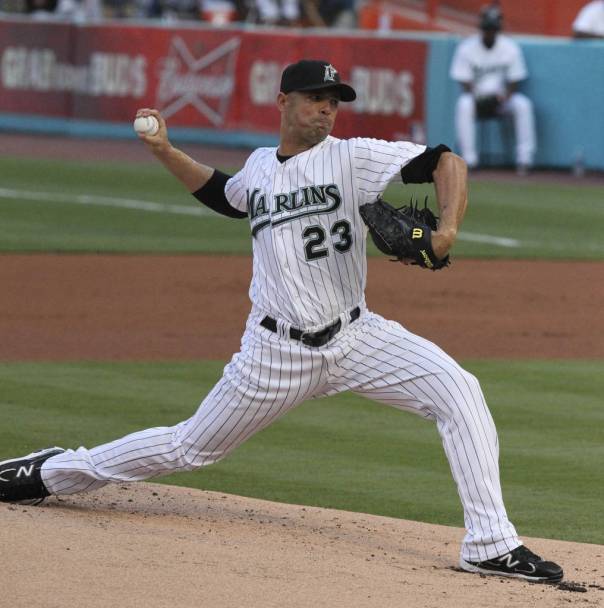Javier Vazquez Behind the Numbers: The Fantasy Value of Pitchers
Monday September 26, 2011
Peter Stein (Fantasy Baseball Analyst – MLB reports): After a historically bad start to the regular season, Javier Vazquez has finished the 2011 campaign on a hot streak to the delight of many fantasy owners who found the 35-year-old right-hander available on the waiver wire. He is ending his season and career with a bang, not allowing a run in his last 25 innings pitched and winning five consecutive starts. His 7 wins, 2.16 ERA, and 87 strikeouts in 87 innings make him one of the strongest starting pitching assets in all of baseball post all-star break.
 Going into the season I actually grossly overpaid for Vazquez and ultimately traded him away. I continued to monitor the pitcher because I knew what he was capable of doing on the mound. However, sitting at 5-8 with a 5.23 ERA at the all-star break, Javy lived up to the criticisms that he has endured throughout his entire career. On paper, Vazquez appears to be one of the most consistent pitchers of the past decade, earning double-digit victories in each of the past twelve seasons. Returning to the NL East, many people, myself included, had high expectations for Vazquez in 2011. After all, he is just two years removed his finest season as a professional with 15 wins and 2.87 ERA for the Atlanta Braves. But the guy is far from consistent. Season to season, month to month, and from start to start you never knew which Javy Vazquez you were going to get – just ask one of his former managers, Ozzie Guillen. http://sports.espn.go.com/mlb/news/story?id=3602173
Going into the season I actually grossly overpaid for Vazquez and ultimately traded him away. I continued to monitor the pitcher because I knew what he was capable of doing on the mound. However, sitting at 5-8 with a 5.23 ERA at the all-star break, Javy lived up to the criticisms that he has endured throughout his entire career. On paper, Vazquez appears to be one of the most consistent pitchers of the past decade, earning double-digit victories in each of the past twelve seasons. Returning to the NL East, many people, myself included, had high expectations for Vazquez in 2011. After all, he is just two years removed his finest season as a professional with 15 wins and 2.87 ERA for the Atlanta Braves. But the guy is far from consistent. Season to season, month to month, and from start to start you never knew which Javy Vazquez you were going to get – just ask one of his former managers, Ozzie Guillen. http://sports.espn.go.com/mlb/news/story?id=3602173
New York Yankee fans are also all too familiar with Vazquez as well, as his stints in the Bronx in both 2004 and 2009 are reminiscent of A.J. Burnett’s 2011 campaign. There is no question that Vazquez is streaky and frustrating to own, for both real and fantasy managers.
However, Vazquez finished 2011, and he says his career, with one of the strongest stretches of his career – conveniently down the stretch for savvy fantasy owners.
So what took Vazquez so long to get his act together in 2011? The answer is actually very clear and it has everything to do with his velocity. To start the season, his average fastball velocity started around 86 miles per hour but steadily increased and finally reached the 92-93 miles per hour range for the second half of the season. http://www.fangraphs.com/pitchfxo.aspx?playerid=801&position=P&pitch=FA
As his fastball velocity increased, so did the frequency in which Vazquez used it. While it’s rare that a 35-year-old regains velocity, it is evident that it was the key to his success. The gain in velocity, coupled with a low-pressure situation in Florida in the NL East, allowed Vazquez to morph back into the pitcher he was in 2009. Although some players rely on velocity more than others, it certainly is a major factor in a pitcher’s success. Just look at Ubaldo Jimenez. With an average fastball velocity of 96mph in 2010, he put together a 19-8 season with a 2.88 ERA. In 2011, his velocity dipped to 93.9 mph and Ublado had trouble getting hitters out, compiling a 10-12 record with an ugly 4.47 ERA. Unless Ubaldo can have a Javy-like resurgence in velocity, he will be forced to improve his secondary pitches and will probably never again be a Cy Young contender.
evident that it was the key to his success. The gain in velocity, coupled with a low-pressure situation in Florida in the NL East, allowed Vazquez to morph back into the pitcher he was in 2009. Although some players rely on velocity more than others, it certainly is a major factor in a pitcher’s success. Just look at Ubaldo Jimenez. With an average fastball velocity of 96mph in 2010, he put together a 19-8 season with a 2.88 ERA. In 2011, his velocity dipped to 93.9 mph and Ublado had trouble getting hitters out, compiling a 10-12 record with an ugly 4.47 ERA. Unless Ubaldo can have a Javy-like resurgence in velocity, he will be forced to improve his secondary pitches and will probably never again be a Cy Young contender.
This gets me to the point of the article. Many fantasy owners tend to ride players who are on hot streaks. But how can you predict these hot streaks when luck plays such a big factor? There needs to be an identifier for success, because all too many times we see players burst onto the scene with a few good starts but soon fizzle away. Sample size is very important, and Vazquez has demonstrated that he is capable of success. It was the gain in velocity and Vazquez’s placement in the NL East that made him a second half commodity. Therefore, before you trust a guy who is “hot”, be sure you do your research and find out why. Otherwise, you are simply gambling. With starting pitchers look for the factors that might contribute to a pitcher’s success: velocity, pitch selection, league and division, and ballpark.
Next week I will take this even further and discuss FIP and XFIP. If you play fantasy baseball and don’t know about www.fangraphs.com, do yourself a favor and familiarize yourself with the site and sabermetrics. This will give you a more accurate depiction of how a pitcher is throwing the ball and better indicators for future success, thereby eliminating the guessing games and searching for “hot streaks.”
***Today’s feature was prepared by our Fantasy Baseball Analyst, Peter Stein. We highly encourage you to leave your comments and feedback at the bottom of the page and share in the discussion with our readers. You can also follow Peter on Twitter (@peterWstein).***
Please e-mail us at: MLBreports@gmail.com with any questions and feedback. You can follow us on Twitter (@MLBreports) and become a fan on Facebook . To subscribe to our website and have the daily Reports sent directly to your inbox , click here and follow the link at the top of our homepage.
Posted on September 26, 2011, in Players: Fantasy Baseball Articles and tagged baseball, burnett, fantasybaseball, indians, jimenez, marlins, mlb, rockies, vazquez, yankees. Bookmark the permalink. Comments Off on Javier Vazquez Behind the Numbers: The Fantasy Value of Pitchers.



You must be logged in to post a comment.